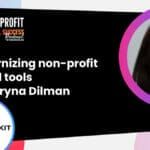Video recording
Audio recording
In today’s episode, we delve deep into the world of non-profit financing. Don’t wait until you’re in a crunch to understand the value of a line of credit for your organization.
Join us as expert Stephen Halasnik shares invaluable insights, dispels myths, and provides a clear roadmap for non-profits seeking financial stability. Whether you’re a seasoned director or just starting out, this episode promises to equip you with essential knowledge. Let’s get started!
Mentioned Resources
Episode Transcription
David Pisarek: Hey, non-profits, volunteers, executive directors, business people, everybody listening to this episode, you need money! That’s the only way that you’re going to be able to do the things that you need to do. Stay afloat, pay your staff. We’re going to be getting into all of that. We’re going to talk about lines of credit with Stephen on this episode. Stephen, thank you so much for joining.
Stephen Halasnik: Yeah, I’m glad to be here. It should be fun.
David Pisarek: Yeah, I think so. So Stephen is a co-founder, a managing partner of Financing Solutions, which since 2010 has been the largest provider of lines of credit to small non-profits in the US. Something else that’s interesting is he doesn’t just do that. He’s also really invested his time and effort in non-profits. He’s on the board of two different non-profits. So thank you, you’re a busy guy. Glad to have you here with me.
Stephen Halasnik: Glad to be here.
David Pisarek: So I guess the best thing to do is let’s talk about what is a line of credit.
Stephen Halasnik: Yeah, so it’s really misunderstood because we get calls all the time from people saying, “I want to buy a building for my non-profit and so I want a line of credit”. And that’s not what a line of credit is for. A line of credit is used for working purposes and working capital. So in other words, it’s used for emergencies. It’s used for short-term type of scenarios, things that happen in weeks or months that are needed, not for years.
So a line of credit is something that you set up in advance.
You have access to the money when you need it and for whatever reason you need it. And so it’s like a safety net, something that it’s really important to have in place.
Having a line of credit has been wanted in the non-profit community for ages. We are one of the few companies that actually work specifically with non-profits, so there are not a lot of choices. A line of credit is really good for, let’s say you have a payroll every two weeks, you can’t miss payroll both legally and morally because you have funding that comes in sporadically. It could be reimbursements, it could be grants, it could be donations, and your cash flow goes up and down.
Every non-profit thinks they’re in the most unique situation where they’re the ones whose balance goes zero. So common amongst the non-profit community to have that scenario. That’s where a line of credit is really good. A loan or a business loan is typically paid back over a 3-5-year period. It’s a fixed amount of money that you get all at once, and then you use it for whatever it is, and then you pay it back over 3-5 years.
And then a mortgage, which we’re all familiar with, can be… If you haven’t got a mortgage, most people don’t know this, a commercial mortgage, which is what a non-profit would use, is paid back over a five to 10-year period, not a 30-year period like a mortgage does for your home. So it acts differently. There’s a balloon payment at the end. And getting into what is a loan, what is a line of credit, and what is a mortgage, are the three most important things that a non-profit should know about.
And let me add the fourth one, startup loans for a non-profit, you will never get one. So don’t even bother. You’re just not going to get a startup loan from any commercial, local bank, or private lender.
You’re just not going to get it. Not only for a non-profit but for a business loan. And we can get other details about secure versus insecure and that type of stuff.
David Pisarek: It’s really interesting. From what I heard you say, the line of credit can really help the leadership of non-profits actually sleep at night a little bit. Not worrying about making payroll, not worrying about having to tell people, “Sorry, can’t pay you”. As you mentioned, there’s this whole ethical thing. We’re working with non-profits. We need to pay our staff that work with us. We need to make sure that they’re able to be happy and they’re able to sleep because then they come to work, they come to volunteer as their best selves.
Stephen Halasnik: Well, they’re not going to come to work if you don’t pay them.
Listen, you have to build credibility with your employees, and if they think your organization is in trouble, they might love the cause, which you’re lucky, most employees at non-profits care about the cause a lot, but they have family obligations and you miss payroll and you start realizing how many people working for you live paycheck to paycheck.
I don’t care what they’re making. You might be paying them $80,000 a year for a fundraising executive and you realize, “Wow, they are living paycheck to paycheck!”. They’ll start looking for a job immediately. The second thing that happens is there’s a legal issue. The Federal government or the state government could come in and shut you right down. There’s a very specific reason for that. They want their money. They want their money. Do they care about employees? Yeah, they do, but they want their money and they’ll come in, they’ll shut you right down or they’ll really put you through the wringer.
There’s the moral part about your employees, and then there’s also the other part, which has to do with the government.
David Pisarek: Are there any minimums in terms of sizes of lines of credit or anything like that?
Stephen Halasnik: Yeah, but it all depends on the organizations you’re dealing with. Listen, the key terminology is “Secure” and “Insecure”. Secure means that you are getting a line of credit and you have collateral to back up the line of credit, which nobody does. Okay, what does that mean? It means you have a building that you own, that your non-profit owns, that you have no mortgage on, or you have one more mortgage on it. And the equity and what’s left, the mortgage minus what the building is worth is equity. Let’s say it’s $200,000 and you go to a bank and you say, “I have $200,000 in equity. Can you give me a line of credit?” And they’ll give you $200,000 and might give you a $20,000 line of credit.
That’s secure, but nobody has security in a non-profit. So you’re unsecured. And that means that I’m looking for a line of credit I don’t have any security for it, and that’s really hard. If you have a lot of security, you can get a bigger line of credit. If you don’t have a lot of security, you’re going to get a smaller line of credit.
Organizations like mine are going to look at, is your cash flow, which is how much revenue you have coming in every month and year. Based on that, we’ll make the determination of what we think you can afford.
David Pisarek: You mentioned earlier about startup loans and startup lines of credit. If I wanted to start a non-profit tomorrow and I got the 501(c)(3) and I’m registered and all that, is it possible to get a line of credit without actually having done anything?
Stephen Halasnik: No. Unless you go get one yourself personally against your home. It’s called a HELOC, a Home Equity Line of Credit, and you give it to a non-profit. Nobody I know does that. Let’s talk about what you do when you’re starting a brand-new non-profit.
There are certain hoops that you have to jump through in order to learn how to build a bigger organization. And if you can’t find a way to get the non-profit going, that skill is going to become more and more valuable as the non-profit grows. So how do you start a new non-profit when you can’t get a loan? And it’s the same thing if you start a business because businesses can’t get startup loans either.
Again, if you have the security, then yes. But the way you have to do it is you have to go get donations. You have to go get big donors, run events, and then there’s these stepping stones. You get to $50,000 a year, then you get to $200,000 a year. That’s a big step. But then you get to a million dollars a year, then you get to $5 million a year, and then you get to 10.
It goes step and step. And each one of those, you’re having to learn how to raise money. And that is grants, donations, government reimbursements, and learning how this all works is a big part of being an executive director and a founder of a non-profit. We get calls all the time saying, “Hey, well, we have this great idea. I want to start this non-profit”, blah, blah, blah. “Can you provide us with the capital?” And we’re like, “We can’t do that. We’re making a decision on the cash flow that’s coming through the organization and what we think you can afford”.
David Pisarek: Part of that affordability is also the rates. The market in the last several months has really jumped up in terms of the rates. How are you seeing that effect play out with your clients?
Stephen Halasnik: You see, when you’re coming to a line of credit, you’re using it for a very short period of time. I’m not really seeing it affect people’s decisions at all. I don’t see many instances where someone uses a line of credit because they’re taking advantage of an opportunity. It just doesn’t happen.
We talk to people about that, but 99% of the time people are using it because they have an emergency, and 75% of the time it’s for payroll.
Someone’s not saying, “Let me use my line of credit so I can hire a grant writer so that I can make that investment so that I can win more grants”. Because the problem is it takes 3-5 years to start winning a grant when you’re just new. This doesn’t make a lot of sense. I do not see rates making a big determination if somebody uses their line of credit or not. Now, do I see more people getting their line of credits now in place? Yeah, I think so. When COVID was around, people were getting what’s called PPP money from the government, which they were giving.
There was also a disaster relief plan from the government. That’s gone. Now people are getting their line of credits more in place.
David Pisarek: Would you recommend that every organization have a line of credit so that if they need one, they’ve got it already there? Or should they think about getting one when it’s closer when they forecast that they might need it?
Stephen Halasnik: You always get the line of credit in advance because there are a couple of things that happen if you don’t get it. One, so it depends on who you’re going to get it from. You’re going to get it from a local bank, a commercial bank, or someone like us who’s a private lender. If you’re going to get it with a commercial bank, it takes three to six months to set it up. When do people want a line of credit?
David Pisarek: When they needed it two weeks ago.
Stephen Halasnik: And two weeks is a good way to look at it because payrolls do every two weeks. They often need it when they’re like, “Oh, my God”. When you go to a bank, it’s a three to six-month process.
And by the way, you don’t even know for a month or two if you’re going to get qualified or not. So when it comes to us, it’s much faster. We’re talking about 10 days to three weeks.
There’s a couple of things. You want to get it in advance because our line of credit doesn’t cost anything to set up. Whereas when you go to a bank, they’re going to charge you points. They’ll be $4,000 to $6,000 to set up a line of credit. With a bank, there’s a lot of documentation you’re going to need. You might need audited financials. We don’t have that. You just need a 990, bank statements, and a couple of other simple stuff. So we make that process really easy. Our line of credit, you’re not required to use it. With a bank, you’re usually required to use it. With a bank, a commercial bank, you have restrictions about how it can be used.
This is a big deal. A bank requires a personal guarantee. We do not. The only caveat we have is if you commit fraud, then we can come after you personally. If your organization closes down because you lost the funding, that’s not a fraud. But if you take the money from the line credit, and move it into your personal account in any book, that’s fraud. You really want to get it set up in advance.
Here’s the other reason. One is because of the emergency of the situation. Number two is if you come to us or a bank and you have a problem, it might scare us off. We might really question your organization. The time to get it is when things are going really well. Listen, I would say if somebody has a non-profit, they’ve been around for seven years, they’ve never had an issue with cash flow, do you get a line of credit in place? With us, it doesn’t cost anything. It’s easy. And you might say, “Hey, listen, it’s good for me to sleep at night”. And that’s a good way to put it too because I’ve been in various businesses for 30 years. I would tell you, that I’ve almost always had a line of credit, but I had one instance where I outstripped my line of credit because we were doing really well.
I went to my bank and asked for an increase and they said, “We’ll let you know in a month”. And I had payroll due. I didn’t sleep that night, and that’s a good way to put it.
I passionately believe in what we do for a living, and that is providing organizations with a line of credit so that they have a backup plan.
And then there’s the other alternative: you go to a board member and they give you a loan. There’s a problem with that. One is the IRS can view that as a lot of problems. You really need to talk to your lawyers about that, which most people don’t know. There could be a conflict of interest in it. And then you still have to pay that person an interest.
And then the other thing that happens is I’ve seen it before where maybe you take that loan from a donor or somebody else, a board member, something happens and you need it again. And it’s really embarrassing to go back to that same person. It makes your organization look a little sketchy like it’s not being run well. And so with having a line of credit, it’s just I dip into my line of credit right now, and so it makes a lot of sense.
We are getting literally 20 to 30 people every single day, non-profits are coming to us wanting to set the line of credit. And it’s a very popular product and there’s a reason for that.
David Pisarek: Is there any insurance or things like that should be considered when getting a line of credit?
Stephen Halasnik: No, I don’t think so.
David Pisarek: Are there any downsides to getting a line of credit?
Stephen Halasnik: Yeah, I think you could say the amount of money that you’re paying in interest or fees is not being used for your cause. But that’s really small-time thinking. If you talk about the for-profit world, they had much more lines of credit set up. Many more times than how many non-profits get it set up.
Now, maybe that’s just because for-profits don’t have as many hurdles to get it in place as a non-profit does. But the fact of the matter is that for-profit businesses use it as a business tool. You might be paying some money out in fees, but you are making sure your organization is running smoothly and that outweighs what you just spent in fees.
David Pisarek: Are there any tax benefits to having a line of credit if you’re paying interest on it or things like that?
Stephen Halasnik: Well, non-profits don’t have write-offs, so they don’t pay taxes on the money you have left over at the end of the year, so no.
David Pisarek: Is there anything else that you think people listening to this should think about or consider if they’re struck by this conversation like, “Oh, you know what? We totally need a line of credit. We don’t have one. I think 30,000 or 50,000 or whatever would be nice to have”. What else do you think they should know?
Stephen Halasnik: I think there are two options. Talk to your local bank, and see what they say. Just to let you know, I got a call today (and I’m telling you the truth, it was just before this call) it was from a loan officer in Florida who works for a local bank with 30 branches. And he called me because he gets a lot of people coming into his office who are non-profits and he can’t help them. So he wanted to know what we do so that we can refer them and he was impressed. But I would still say, talk to your local bank, and then I would say, talk to us.
There’s not a lot of players. We’re the number one player in the space. So you go to financingsolutionsnow.com or to make it even simpler, go to fscreditline.com. F and S, as in Finance and Solutions Credit Line. And you can read about us, but you can also fill out a simple two-minute application. There are no documents required initially, and we will tell you how much you qualify for. And if you don’t qualify, why? And then, of course, if you do qualify, then we’ll put in writing how much it all costs.
It’s not complicated. That’s again, fscreditline.com. I would suggest going to a local bank, seeing what they say, and then checking out fscreditline.com.
David Pisarek: That’s amazing. I think that the work that you’re doing, the time, the effort that you’re putting in, helping organizations be able to be more successful, help more people in their communities, stay afloat so that they can be doing the great work that they set out to do and why they started their non-profit, I think it’s really important.
Stephen Halasnik: Well, it’s great. Every day I get thanks. I am running a business, but I’m not exaggerating. I get people like, “Wow, thank you for giving us this line of credit”, or “You really saved our lives. I didn’t think we were going to need it”. It’s a smart thing to get in place. It’s a no-brainer to me.
I’m a little bit amazed, sometimes we get people saying “We’re going to go to a bank and talk to them and see what they’re…” And they always end up coming back. But I think an educated person in this regard is helpful. Hopefully, the information I’ve provided to everybody today: what is a line of credit? What is it used for? Why is it valuable? That’s the main purpose of why I think today is going to be valuable.
David Pisarek: Absolutely. I want to thank you so much for being here. I know that other people listening to this, if you were inspired by this episode, I would love to encourage you to subscribe to the NonProfit MBA podcast. Stephen is the host of that podcast as well, so in good company here as well.
Stephen Halasnik: Yeah, and that’s a great podcast because we’ve had 450 episodes and our guests are amazing. I always say that if you just listen to those podcasts and David’s podcast too, Wow. Really, you don’t need to read any books. Just listen to the podcast. It saves you time. You get good information. The nice thing about having 450 episodes, and Dave, I don’t know how many you have as well.
David Pisarek: We are at just over 70 when this one gets published.
Stephen Halasnik: The fact is I know what people do and they don’t listen to every single one. What they do is they pick and choose which ones they’re having a problem with or if they have an interest and that’s the one they listen to. I think that my podcast in particular, which I’ve been doing for four and a half years now, just has so many great people on it.
David Pisarek: Stephen, these have been some amazing insights around loans, lines of credit, and different ways that people can maybe start thinking about how to help fund some of the work that they want to do or keep afloat, help them sleep at night, feel a little bit more relaxed so they can focus on their fundraising efforts.
I hope the people listening have gotten some great advice insight and pointers from you today. And if you were to challenge anybody listening to this to do one thing coming out of this episode, what would that be?
Stephen Halasnik: Take better care of themselves.
I say at the end of every single one of my podcasts, “Non-profit executive directors are doing the heavy lifting of trying to save the world and do really good things to save people”. I thank them for that. We really need you.
I know David and I both do our own part in our own way, in our own personal lives to try to do our best. But you’re not good to your family, your friends, your employees, your cause if you don’t think of yourself first and then do your cause. We all know that executive directors are intense about trying to solve problems and they forget about themselves. So take care of yourself first and everything else will fall into place.
David Pisarek: I love that. I think that’s a really great idea. When people go on an airplane, they say “Put your mask on in case of emergency and then help the person beside you”. A very similar type of thing. If you’re not in a clear mental headspace and focus space, it’s hard to get and rally the people around you to keep fighting the good fight that we’re all trying to do.
Stephen Halasnik: Yep, and it’s a marathon and a sprint.
David Pisarek: Absolutely. Just to recap again, if anybody wants to get in touch with you, Stephen, what do they need to do?
Stephen Halasnik: Just go to fscreditline.com. All the information is right there. We’re certified by the Better Business Bureau. We’re five-star rated by Google Reviews and the Better Business Bureau. We’ve been around a long time. We really know what we’re doing and we’re very straight-shooters. We’re honest.
David Pisarek: Thanks again, Stephen, for joining in on the podcast. It’s been great having you here on the Non-profit Digital Success Podcast.
To everybody listening, if you want any of the links or resources that Stephen provided, just head over to our podcast page at nonprofitdigitalsuccess.com. Click on this episode for the details. Go on YouTube, like it, favourite it, subscribe, share it. And until next time, keep on being successful!














0 Comments